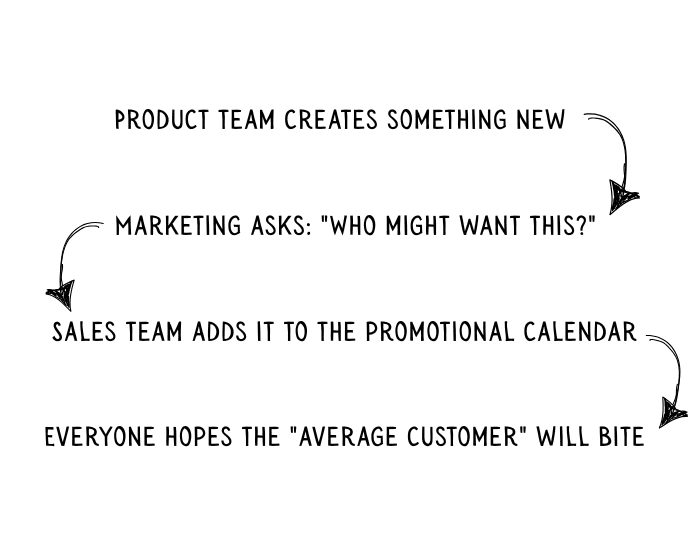Loyalty Blueprint Step 2. Place humans above your products
AN
Stop chasing the mythical average. Start solving real customer problems.

The Myth of the "Average Customer"
"Our average customer spends €47 and visits us 2.3 times per month. She's 68% female and 34 years old."
Sound familiar? This is how most companies describe their customers: in averages, demographics, and tidy statistics. It feels comfortable. It's easy to present to executives. Everyone nods and says, "Now we know our customers!"
But here's the uncomfortable truth: There is no such thing as an average customer. This should become your new mantra.
Think about it: When was the last time you met someone who was 68% female or visited a store 2.3 times? These numbers might help with spreadsheets, but they don't help you connect with real people who have real problems, emotions, and motivations.
The Product-First Trap
When brands rely on averages, they fall into the product-first trap. The process looks like this:

This approach is like playing a guessing game where you keep asking the same yes/no questions: "Want this product? How about this one? This one?" Some people say yes, but most say no. And after the third "no," they stop listening entirely.
The result? You're constantly pushing products that only appeal to a fraction of your audience, while the majority feels disconnected from your brand.
The Real Cost of Thinking Product-First
When you lead with products instead of people, several things happen:
- You lose potential customers who aren't currently interested in what you're promoting, even though they might love other aspects of your brand.
- Your marketing becomes inefficient because you're broadcasting generic messages to diverse audiences with different needs.
- You miss innovation opportunities because you're not listening to what customers actually struggle with in their daily lives.
- Your teams operate in silos with product managers focused on features, marketers focused on campaigns, and customer service dealing with the disconnect.
What Does "Humans First" Actually Mean?
Putting humans above products means starting every decision with a simple question: "What problem are we solving for real people?"
Instead of asking "How do we sell more widgets?" you ask:
- "What makes our customers' lives difficult?"
- "What are they trying to accomplish?"
- "Where do they get stuck in their journey with us?"
- "What would make them genuinely excited to engage with our brand?"
This shift changes everything. Instead of pushing products, you start solving problems. Instead of talking at customers, you start listening to them.
Putting humans above products means starting every decision with a simple question: "What problem are we solving for real people?"
The Data Advantage: From Demographics to Understanding
As a loyalty professional, you have something most marketing teams lack: rich behavioral data and direct customer relationships.
While others see "female, 34, shops twice monthly," you can see:
- Sarah, who always shops on Tuesday mornings because that's when her kids are at school
- Maria, who buys in bulk monthly because she's managing a busy household
- Emma, who browses frequently but only buys during sales because she's budget-conscious
Putting humans above products means starting every decision with a simple question: "What problem are we solving for real people?"
This depth of understanding comes from combining what you observe (behavior) with what you ask (feedback) and what you test (reactions to different approaches).
How to Operationalize Human-First Thinking
- Create Customer Insight Loops. Don't just collect data, but actively seek understanding through:
- Post-purchase surveys asking "What problem did this solve for you?"
- Customer service interaction analysis
- Social listening for unfiltered opinions
- Focus groups with your most engaged members
- Map Problems, Not Just Journeys. Traditional customer journey mapping shows touchpoints. Human-first mapping shows frustrations, motivations, and desired outcomes at each stage.
- Test Solutions, Not Just Products. Before launching a new product, test whether it actually solves the problem you think it does. Sometimes the solution isn't a new product: it's better service, clearer information, or a simpler process.
- Empower Front-Line Teams. Your customer service team hears problems every day. Your store associates see customer behavior firsthand. Create channels for these insights to reach decision-makers.
Beyond Marketing: The Organizational Shift
When you truly put humans first, the impact goes far beyond marketing campaigns:
- Product Development starts with customer problems rather than technical possibilities.
- Customer Service becomes proactive problem-solving rather than reactive damage control.
- Operations are optimized for customer convenience, not just internal efficiency.
- Communication becomes relevant and helpful rather than promotional and pushy.
Your Role as the Human Advocate
As a loyalty leader, you're uniquely positioned to champion this shift. You own:
- Direct customer relationships through your program.
- Rich behavioral data showing what people actually do, not just what they say.
- Cross-functional influence connecting marketing, service, and product teams
- Permission to experiment with different approaches and measure results
Your mission: become the voice of the customer in every business decision.
The Competitive Advantage
Brands that master human-first thinking don't just win customers. They create advocates. When people feel understood and valued as individuals, they don't just buy; they recommend, they engage, and they forgive mistakes.
Companies like Amazon, Netflix, and Spotify didn't succeed by having the best products initially. They succeeded by understanding human behavior and solving real problems better than anyone else.
Starting Your Human-First Journey
Your brand offers much more than just products. You have the power to solve customer problems and make their lives easier every day.
Week 1: Replace "average customer" language in one presentation with specific customer examples and their unique motivations.
Week 2: Ask your customer service team: "What are the top 3 problems customers complain about that aren't product-related?"
Week 3: Survey 100 recent customers with one question: "What were you trying to accomplish when you first came to us?"
Week 4: Present these insights to your product or marketing team with the question: "How might we solve these problems better?"
The goal isn't to abandon products. It's to ensure every product, service, and interaction serves a genuine human need.
Remember: Your brand offers much more than just products. You have the power to solve customer problems and make their lives easier every day. When you identify needs early, you don't just discover better solutions, you build deeper relationships.